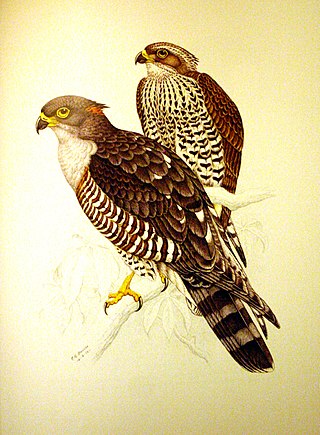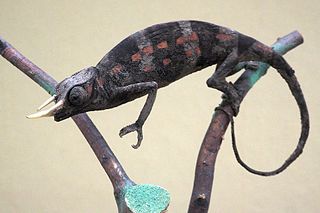
Chamaeleo is a genus of chameleons in the family Chamaeleonidae. Most species of the genus Chamaeleo are found in sub-Saharan Africa, but a few species are also present in northern Africa, southern Europe, and southern Asia east to India and Sri Lanka.

Jackson's chameleon, also known as Jackson's horned chameleon, three-horned chameleon or Kikuyu three-horned chameleon, is a species of chameleon native to East Africa, but also introduced to Hawaii, Florida, and California.

Parson's chameleon is a large species of chameleon in the family Chamaeleonidae. The species is endemic to isolated pockets of humid primary forest in eastern and northern Madagascar. It is listed on CITES Appendix II, meaning that trade in this species is regulated. While most chameleon species from Madagascar cannot be legally exported, a limited number of Parson's chameleons can be legally exported each year from its native country.

The African cuckoo-hawk, or African baza, is a medium-sized raptor in the family Accipitridae so named because it resembles the common cuckoo. It is found in sub-Saharan Africa and along the eastern parts of Southern Africa, preferring dense woodland and forest of either indigenous or exotic trees.

The common chameleon or Mediterranean chameleon is a species of chameleon native to the Mediterranean Basin and parts surrounding the Red Sea. It is the only extant species of Chamaleonidae with a range that naturally extends into Europe.

Trioceros melleri, with the common names Meller's chameleon and giant one-horned chameleon, is the largest species of chameleon from the African mainland.

The flap-necked chameleon is a species of arboreal chameleon, a lizard in the family Chamaeleonidae. The species is native to sub-Saharan Africa. There are eight recognized subspecies, including the nominotypical subspecies.

Chilabothrus gracilis is a species of nonvenomous snake in the Boidae family. It is endemic to Hispaniola.

Marshall's pygmy chameleon, also called Marshall's leaf chameleon, Marshall's dwarf chameleon, or Marshall's stumptail chameleon, is a species of chameleon found in the forests of Zimbabwe and Mozambique in Africa. It grows from 3.5 to 7.5 cm and feeds on insects. When standing still, it resembles a leaf on a branch.

The Petter's chameleon is a species of chameleon, which is endemic to northern Madagascar. Furcifer petteri was initially described as the subspecies Chamaeleo willsii petteri by Édouard-Raoul Brygoo and Charles Domergue in 1966, but later transferred to the genus Furcifer and given full species status by Frank Glaw and Miguel Vences in 1994.

The crested chameleon, Trioceros cristatus, is a species of chameleon endemic to Africa. The species was first described by Samuel Stutchbury in 1837.

The African chameleon or Sahel chameleon is a species of chameleon native to the Sahel and Nile Valley, with an introduced population present in Greece. An average size may be around 34 cm (13 in) long, including its tail.

The smooth chameleon is a species of chameleon native to Africa. It is bluish-green and has small scales. Its body is very slender, and it looks similar to Chamaeleo senegalensis.

Crotaphopeltis hotamboeia, commonly known as the herald snake or the red-lipped snake, is a species of snake in the family Colubridae. The species is endemic to Sub-Saharan Africa.

Owen's chameleon, also commonly known as Owen's three-horned chameleon, is a species of chameleon in the family Chamaeleonidae. The species is native to sub-Saharan Africa. Named after British naval officer and explorer William Fitzwilliam Owen, it was first described in 1831 by the naturalist John Edward Gray, and is the type species of the genus Trioceros.

Kinyongia uthmoelleri, known commonly as the Hanang hornless chameleon, Müller's leaf chameleon, and Uthmöller's chameleon, is species of lizard in the family Chamaeleonidae. The species is endemic to Tanzania.

The four-horned chameleon is a species of chameleon, a lizard in the family Chamaeleonidae. The species is native to highland areas in western Cameroon and southeastern Nigeria.

Aristelliger praesignis, is a species of gecko, a lizard in the family Sphaerodactylidae. The species is endemic to Jamaica and the Cayman Islands.

Trioceros ellioti, also known commonly as Elliot's chameleon, Elliot's groove-throated chameleon, and the montane side-striped chameleon, is a species of lizard in the family Chamaeleonidae. The species is indigenous to Africa.





















